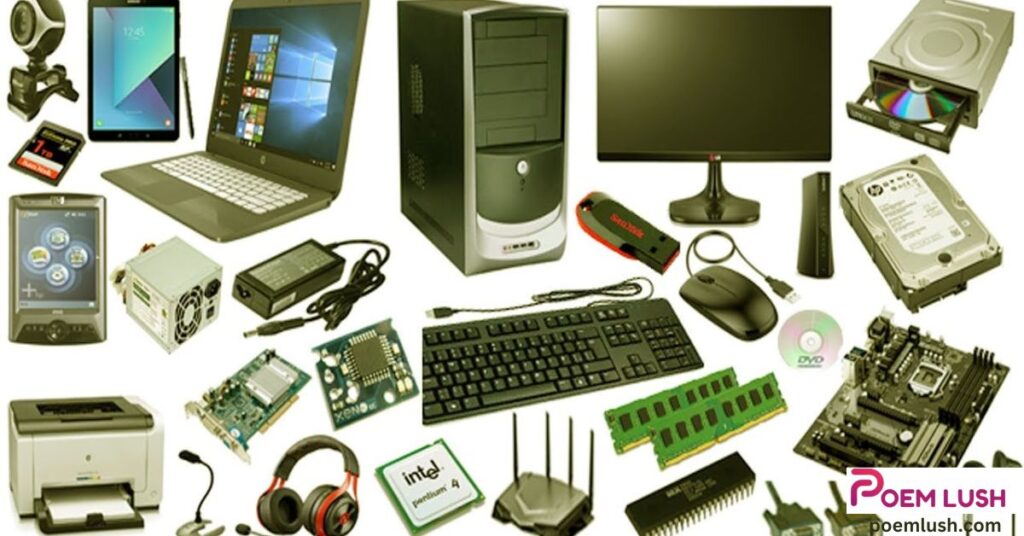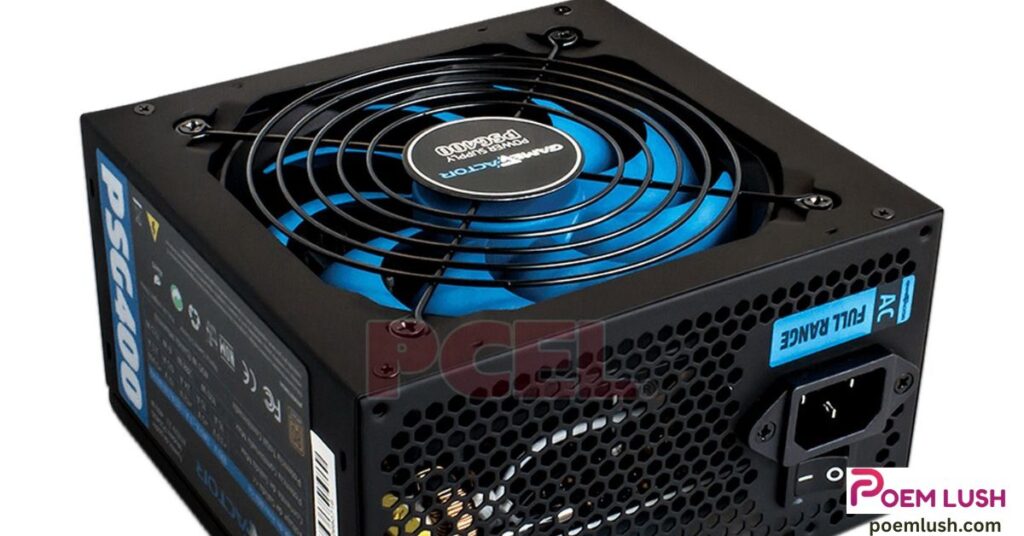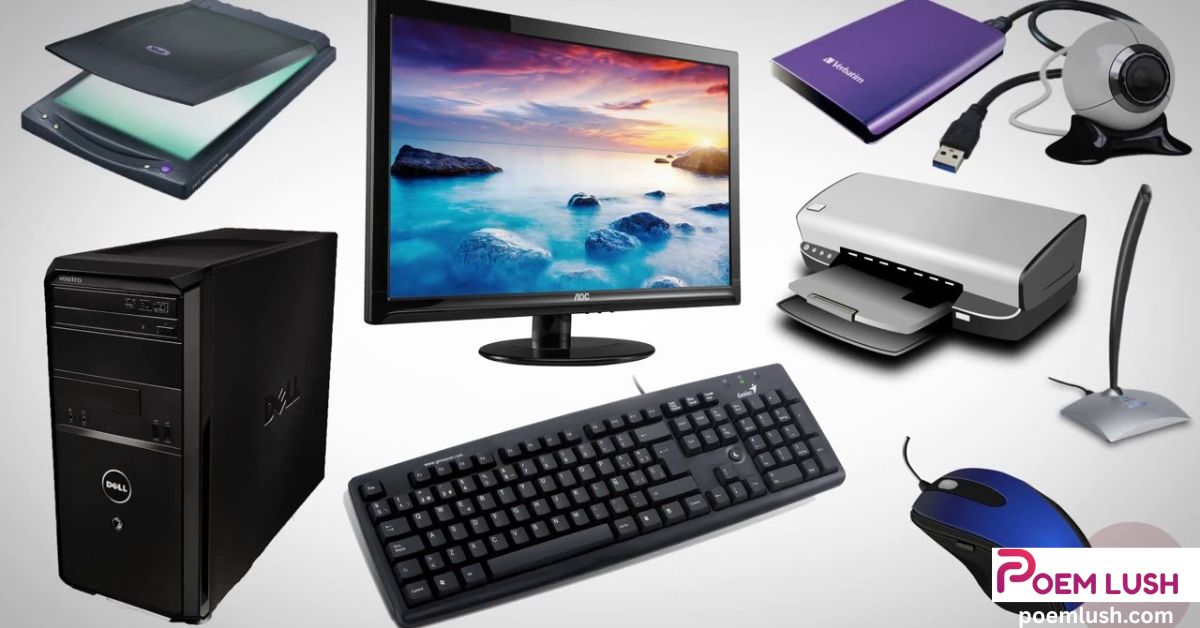Computer Parts Name with Picture Whether you’re a beginner exploring your first desktop build or just curious about what makes your laptop tick, understanding the computer parts name with picture is a crucial first step. This guide gives you a complete breakdown of internal and external hardware components with high-quality images and in-depth explanations.
We’ll walk you through essential computer parts, describe their function, show you what they look like, and explain how they work together. This isn’t just surface-level info you’re getting real, practical knowledge to help you better understand or build your own machine. Computer Parts Name with Picture
What Are Computer Parts?

Computer parts refer to the physical hardware components that form a complete computing system. These parts are typically categorized into two main groups: Computer Parts Name with Picture
- Internal components: Located inside the computer case, they perform processing, storage, and control tasks.
- External peripherals: Devices like keyboards, mice, and monitors that allow input and output operations.
Here’s a quick comparison:
| Category | Examples | Purpose |
| Internal | CPU, RAM, SSD, Motherboard | Perform computation, storage, logic |
| External | Keyboard, Mouse, Monitor | Enable user interaction |
Central Processing Unit (CPU)
The CPU, or Central Processing Unit, is often referred to as the brain of the computer. It executes instructions from programs and coordinates the actions of all other hardware components. Computer Parts Name with Picture
Function
- Processes instructions from software applications
- Manages communication between system parts
Key Specs
- Cores: More cores = better multitasking (e.g., 4-core, 8-core, 16-core)
- Clock Speed: Measured in GHz (e.g., 3.6 GHz)
- Threads: Virtual cores that improve parallel processing
Popular CPU Brands
- Intel: Core i3, i5, i7, i9
- AMD: Ryzen 3, 5, 7, 9
CPU Image
LSI Keywords: main processor, processing unit, computer brain
Motherboard
The motherboard is the main circuit board that holds and connects all other internal components. Computer Parts Name with Picture
Function
- Connects CPU, RAM, GPU, storage, and power
- Allows communication between all parts
Form Factors
- ATX: Full-sized boards for high-end builds
- Micro-ATX: Smaller, budget-friendly
- Mini-ITX: Compact systems
Features to Consider
- Number of RAM slots
- PCIe slots for GPU
- M.2 or SATA ports for storage
Motherboard Image
LSI Keywords: system board, logic board, PC mainboard
Random Access Memory (RAM)
RAM, or Random Access Memory, is your system’s short-term memory. It temporarily stores data the CPU is actively using.
Function
- Temporarily holds application data
- Enables smooth multitasking and faster processing
Types
- DDR4: Most common
- DDR5: Newest, faster, energy-efficient
Typical Sizes
- 8GB (basic use)
- 16GB (gaming and productivity)
- 32GB+ (video editing, development)
RAM Image
LSI Keywords: system memory, memory module, fast memory
Graphics Processing Unit (GPU)
The GPU, or Graphics Processing Unit, renders images, video, and animations.
Function
- Handles graphic-intensive tasks
- Renders 2D/3D graphics, video playback
- Crucial for gaming, video editing, 3D rendering
Types
- Integrated GPU: Built into CPU
- Dedicated GPU: Separate hardware (e.g., NVIDIA, AMD cards)
Top Brands
- NVIDIA: GeForce GTX, RTX series
- AMD: Radeon RX series
GPU Image
LSI Keywords: graphics card, visual processor, graphics accelerator
Hard Disk Drive (HDD)
HDDs are traditional mechanical storage devices.
Function
- Long-term data storage using spinning disks
- Stores files, software, OS, documents
Advantages
- Larger capacity (1TB, 2TB+)
- Cheaper than SSDs
HDD Image
LSI Keywords: magnetic storage, disk drive, storage drive
Solid State Drive (SSD)
SSDs are modern, faster alternatives to HDDs.
Function
- Fast read/write speeds
- Quicker boot times and software launch
Types
- SATA SSD: Cheaper, 2.5″ format
- NVMe M.2 SSD: Faster, compact
SSD Image
LSI Keywords: flash storage, solid drive, fast storage
Power Supply Unit (PSU)

The PSU powers every component inside your computer.
Function
- Converts AC electricity into usable DC
- Distributes power to CPU, GPU, drives, motherboard
Ratings
- Wattage: 450W–850W typical
- Efficiency: 80+ Bronze, Gold, Platinum
PSU Image
LSI Keywords: power module, power source, power converter
Network Interface Card (NIC)
A NIC allows your computer to connect to networks.
Function
- Connects via Ethernet or Wi-Fi
- Enables internet access and file sharing
Types
- Wired NIC: RJ-45 Ethernet port
- Wireless NIC: Wi-Fi antennas
NIC Image
LSI Keywords: network adapter, LAN card, ethernet card
Cooling System
Cooling Fans
- Help airflow and prevent overheating
- Usually intake (front/bottom) and exhaust (rear/top)
LSI Keywords: system cooling, heat dissipaters, airflow fans
Heat Sinks & Liquid Coolers
- Passive (heatsinks) or active (fans/liquid)
- High-performance CPUs/GPU need better cooling
Fan Placement Diagram
Computer Case (Chassis)
Function
- Protects and holds all internal components
- Manages cable routing and airflow
Case Sizes
- Full Tower: High-end builds
- Mid Tower: Standard builds
- Mini ITX: Compact systems
Case Image
LSI Keywords: chassis, PC case, enclosure
Drive Bays
Function
- Slots for mounting HDDs, SSDs, and optical drives
- External or internal bays
Drive Bay Image
LSI Keywords: storage bays, bay expansion, drive slots
Input Devices
Keyboard
- Mechanical vs membrane
- USB or wireless
Mouse
- DPI sensitivity, ergonomics
Images
LSI Keywords: input hardware, control device, input peripherals
Output Devices
Monitor
- Display resolution (1080p, 1440p, 4K)
- Refresh rate (60Hz, 144Hz+)
Speakers
- Stereo and surround systems
Images
LSI Keywords: visual output, sound output, output peripherals
Optional Computer Components
- External hard drives: Backup and portability
- Webcams and microphones: For communication
- USB hubs and docking stations: Expand connectivity
Picture Grid Example:
- 4–6 optional accessories shown in one image layout
Summary Table: Key Computer Parts Name with Picture
| Component | Description | Internal/External | Image Link |
| CPU | Processes instructions | Internal | |
| RAM | Temporary memory | Internal | |
| SSD | Fast storage | Internal | |
| Monitor | Visual output | External | |
| Keyboard | Input device | External |
Beginner Tips for Choosing the Right Computer Parts
- Compatibility is key: Always match CPU socket with motherboard
- Balance performance: Don’t pair a powerful GPU with a weak CPU
- Prioritize upgrades:
- First: SSD (for speed)
- Second: RAM (for multitasking)
- Third: GPU (for graphics)
- First: SSD (for speed)
Frequently Asked Questions

What are the 5 most important computer parts?
CPU, RAM, Storage (SSD/HDD), Motherboard, PSU
Can I use a PC without a GPU?
Yes, if your CPU has an integrated GPU (like Intel i5-12400)
Which part makes a computer faster?
SSD improves speed the most for average users
What’s the difference between SSD and HDD?
SSDs are faster, quieter, and more durable. HDDs are cheaper per GB.
Certainly! Here’s a clear and informative conclusion for an article titled “Computer Parts Name with Picture”:
Conclusion
Understanding the names of computer parts with pictures isn’t just for tech experts it’s essential for anyone who uses a computer. From the powerful CPU to the storage-driven hard drive, each component plays a vital role in how your computer functions.
By seeing these parts visually, it becomes easier to grasp their purpose, how they connect, and why they matter. Whether you’re building your own PC, troubleshooting an issue, or just curious, knowing your computer inside and out empowers you to make smarter decisions.
So next time you open a laptop or sit at a desktop, you’ll recognize the parts not as mystery pieces but as familiar tools driving your digital world.
FAQs
What are the basic parts of a computer?
Monitor, CPU, keyboard, mouse, and storage.
What is a CPU?
It’s the brain of the computer that processes instructions.
Is RAM permanent?
No, RAM is temporary memory that clears when power is off.
What’s the use of a hard drive?
It stores your data, files, and the operating system.
Can I upgrade my computer parts?
Yes, many parts like RAM, storage, and GPU can be upgraded.


